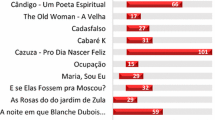Abstract
This paper examines the impact of financial and socio-economic factors on repertoire decisions of the grant-aided, non-profit theatre sector in England using cross-sectional regression analysis for the seasons 1996/97 to 1998/99. The dependent variable, a conventionality index, a variant of the DiMaggio/Stenberg conformity index, is calculated first. This shows a very considerable variation in repertoire conventionality, so measured, in the non-profit English theatre sector. A model is then constructed to assess the impact of the above-mentioned factors in determining variations in this index using a dataset hitherto not analysed in this way. The empirical results show that public subsidy, the size and the location of a theatre as well as the local average income have an impact on conventionality, which confirms existing empirical findings.
Similar content being viewed by others
References
Austen-Smith, D. (1980) “On the Impact of Revenue Subsidies on Repertory Theatre Policy.” Journal of Cultural Economics 4: 9–17.
Boyden Associates (2000) A Report for the ACE on the Roles and Functions of the English Producing Theatres. Stage One. Summary. Arts Council of England, Bristol.
Castañer, X. and Campos, L. (2002) “The Determinants of Artistic Innovation: Bringing in the Role of Cultural Organisations.” Journal of Cultural Economics 26: 29–52.
Caves, R. (2000) Creative Industries. Harvard University Press, Boston.
Davidson, R. and McKinnon, J. G. (1993) Estimation and Inference in Econometrics. Oxford University Press, New York.
DiMaggio, P. and Stenberg, K. (1985a) “Conformity and Diversity in American Resident Theatres”, in Judith Balfe and Margaret Wyszomirski (eds.), Arts, Ideology and Politics. Praeger, New York, pp. 116–143.
DiMaggio, P. and Stenberg, K. (1985b) “Why do Some Theatres Innovate More than Others? An Empirical Analysis.” Poetics 14: 107–122.
Heilbrun, J. (2001) “Empirical Evidence of a Decline in Repertory Diversity among American Opera Companies 1991/92 to 1997/98.” Journal of Cultural Economics 25: 63–72.
Jenkins, S. and Austen-Smith, D. (1987) “Interdependent Decision-Making in Non-Profit Industries. A Simultaneous Equation Analysis of English Provincial Theatre.” International Journal of Industrial Organization 5:149–174.
Krebs, S. (1996) Öffentliche Theater in Deutschland. VWF, Berlin.
Krebs, S. and Pommerehne, W.W. (1995) “Politico-economic Interactions of German Public Performing Arts.” Journal of Cultural Economics 19: 17–32.
Long, J.S. and Ervin, L. H. (2000) “Using Heteroscedasticity Consistent Standard Errors in the Linear Regression Model.” The American Statistician 54: 217–224.
Martorella, R. (1977) “The Relationship Between Box Office and Repertoire: A Case Study of Opera.” The Sociological Quarterly 18: 354–366.
Montias, J.M. (1983) “Public Support for the Performing Arts in Europe and the United States,” in Gustav R. and Robert L. West (eds.), Comparative Development Perspectives. Westview Press, Boulder Colorado, and reprinted in Paul DiMaggio (1986) Nonprofit Enterprise in the Arts. Studies in Mission and Constraint. Oxford University Press, New York, pp. 287–319.
O’Hagan, J.W. (1998) The State and the Arts: An Analysis of Key Economic Policy Issues in Europe and in the United States. Edward Elgar, Cheltenham.
O’Hagan, J.W. and Neligan, A. (2001) “Innovation and Diversity in Repertoire in Grant-aided and Commercial Theatre”, in Sara Selwood (ed.), The UK Cultural Sector: Profile and Policy Issues. Policy Studies Institute, London, pp. 217–234.
Pierce, J.L. (2000) “Programmatic Risk-Taking by American Opera Companies.” Journal of Cultural Economics 24: 45–63.
Schulze, G. and Rose, A. (1998) “Public Orchestra Funding in Germany – An Empirical Investigation.” Journal of Cultural Economics 22: 227–247.
Throsby, D.C. (1994) “The Production and Consumption of the Arts: A View of Cultural Economics.” Journal of Economic Literature 32: 1–29.
Author information
Authors and Affiliations
Corresponding author
Rights and permissions
About this article
Cite this article
O’Hagan, J., Neligan, A. State Subsidies and Repertoire Conventionality in the Non-Profit English Theatre Sector: An Econometric Analysis. J Cult Econ 29, 35–57 (2005). https://doi.org/10.1007/s10824-005-8132-y
Issue Date:
DOI: https://doi.org/10.1007/s10824-005-8132-y




